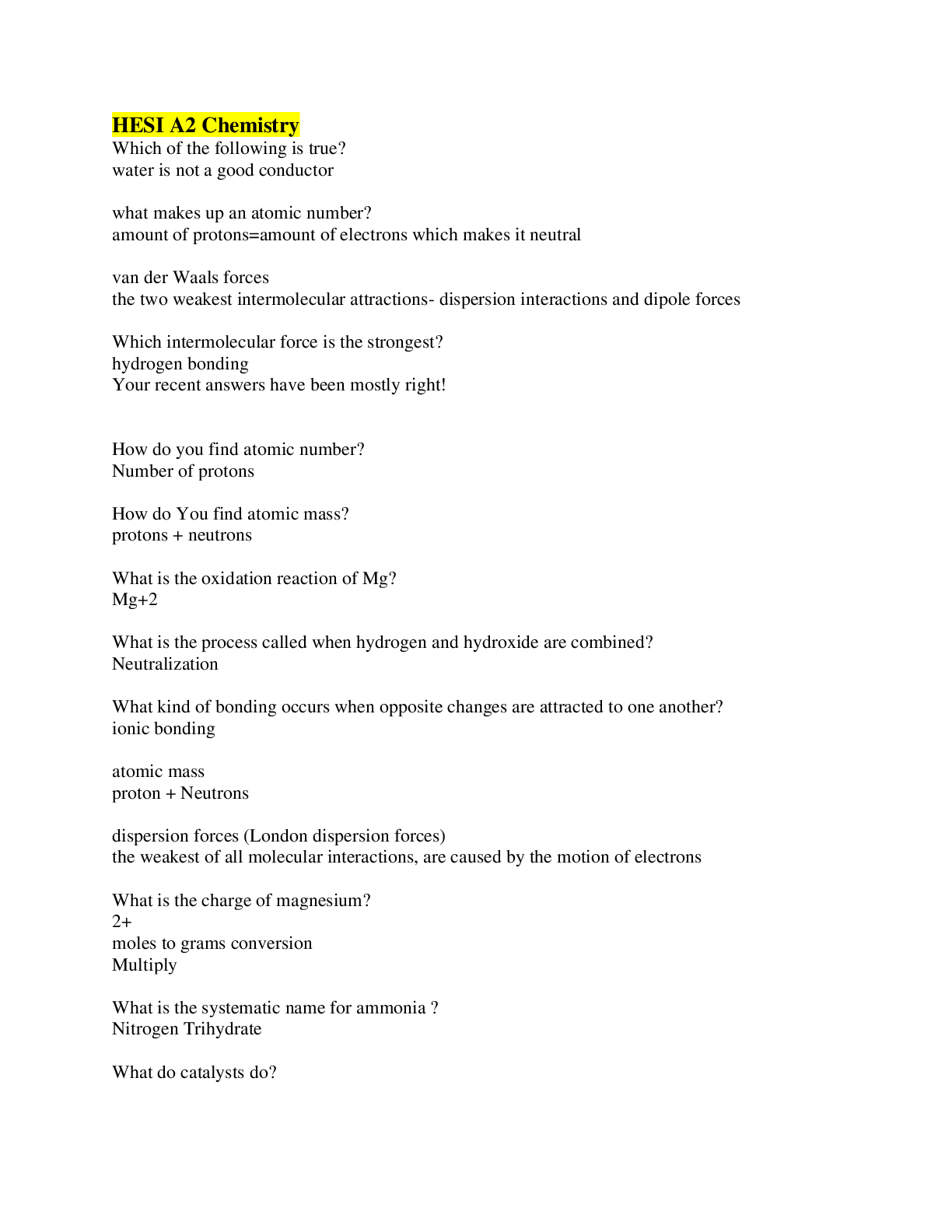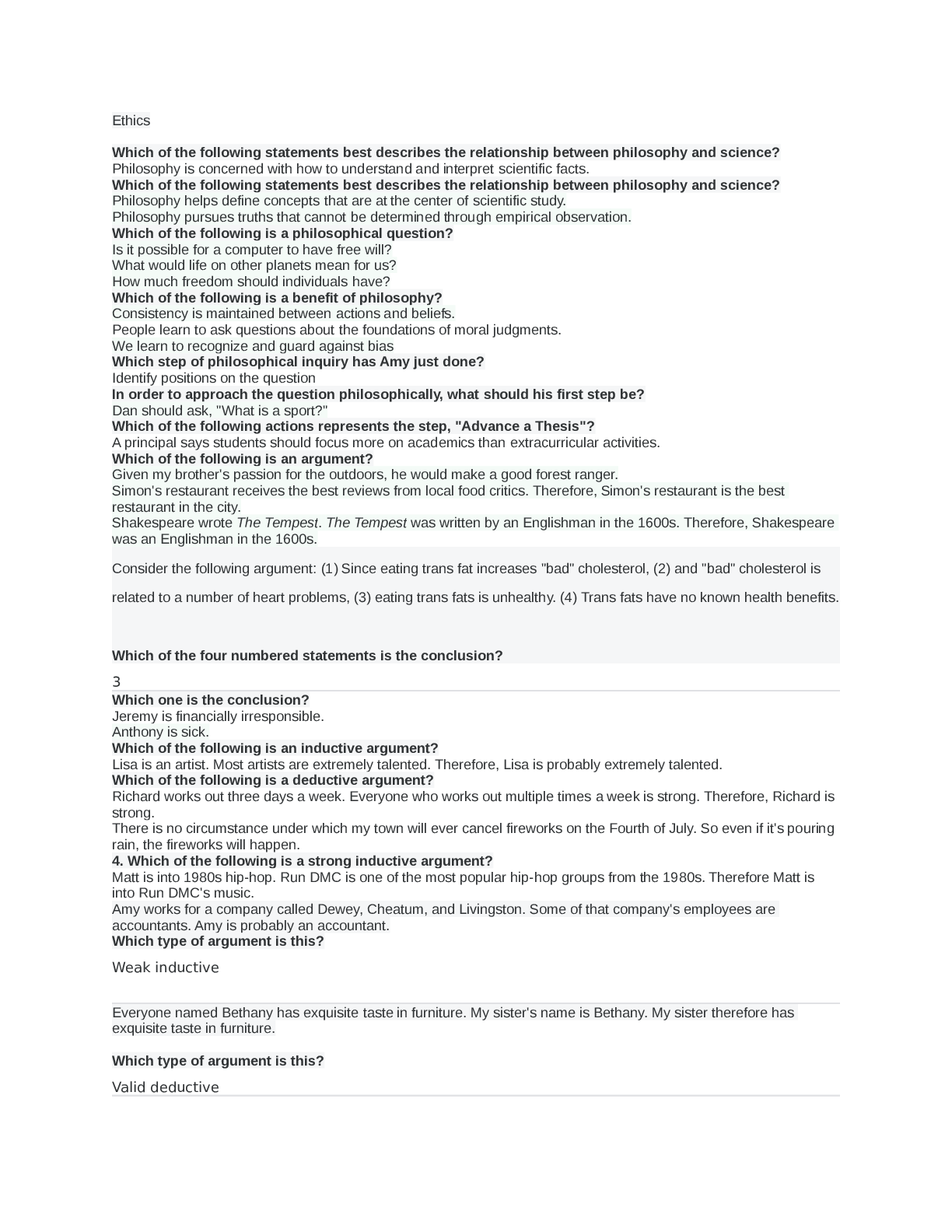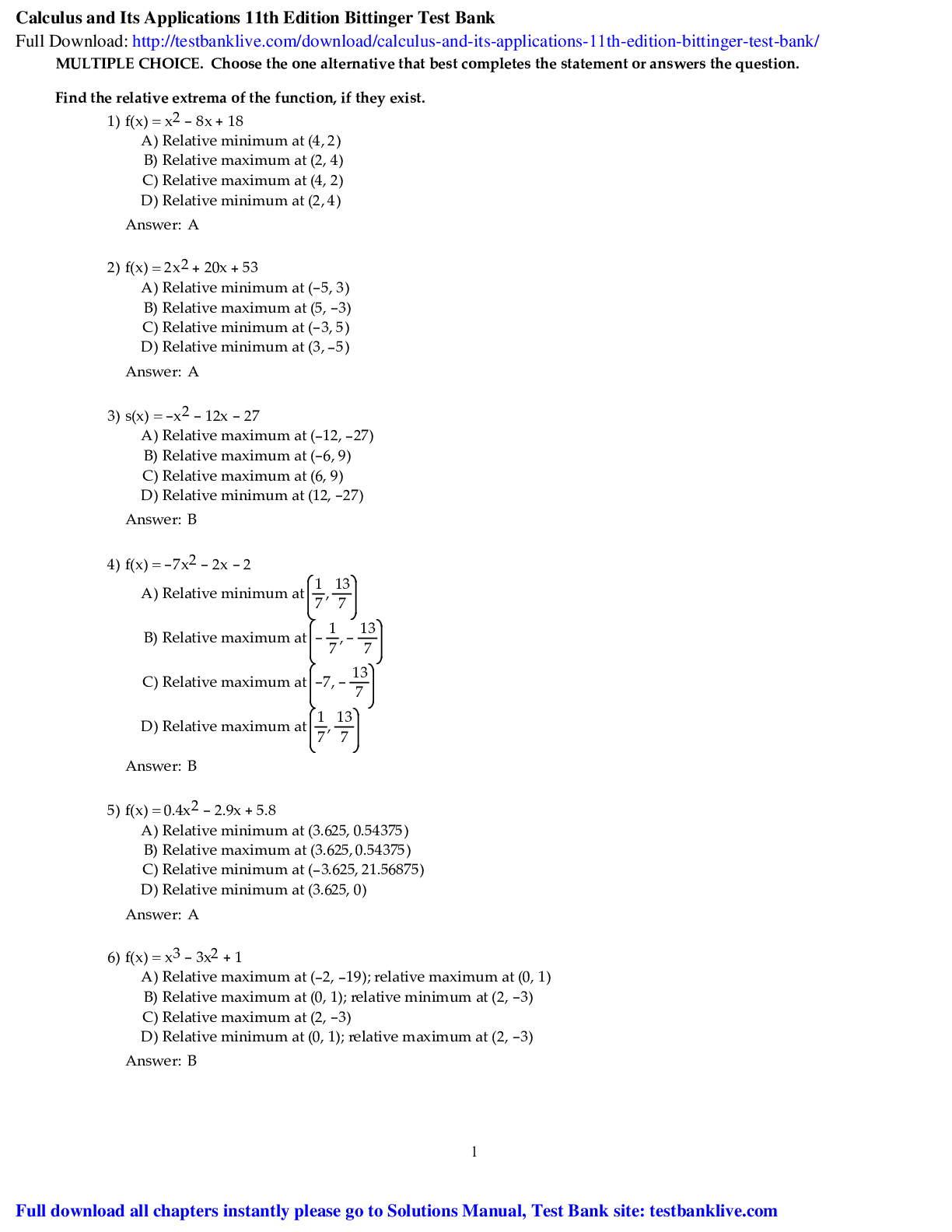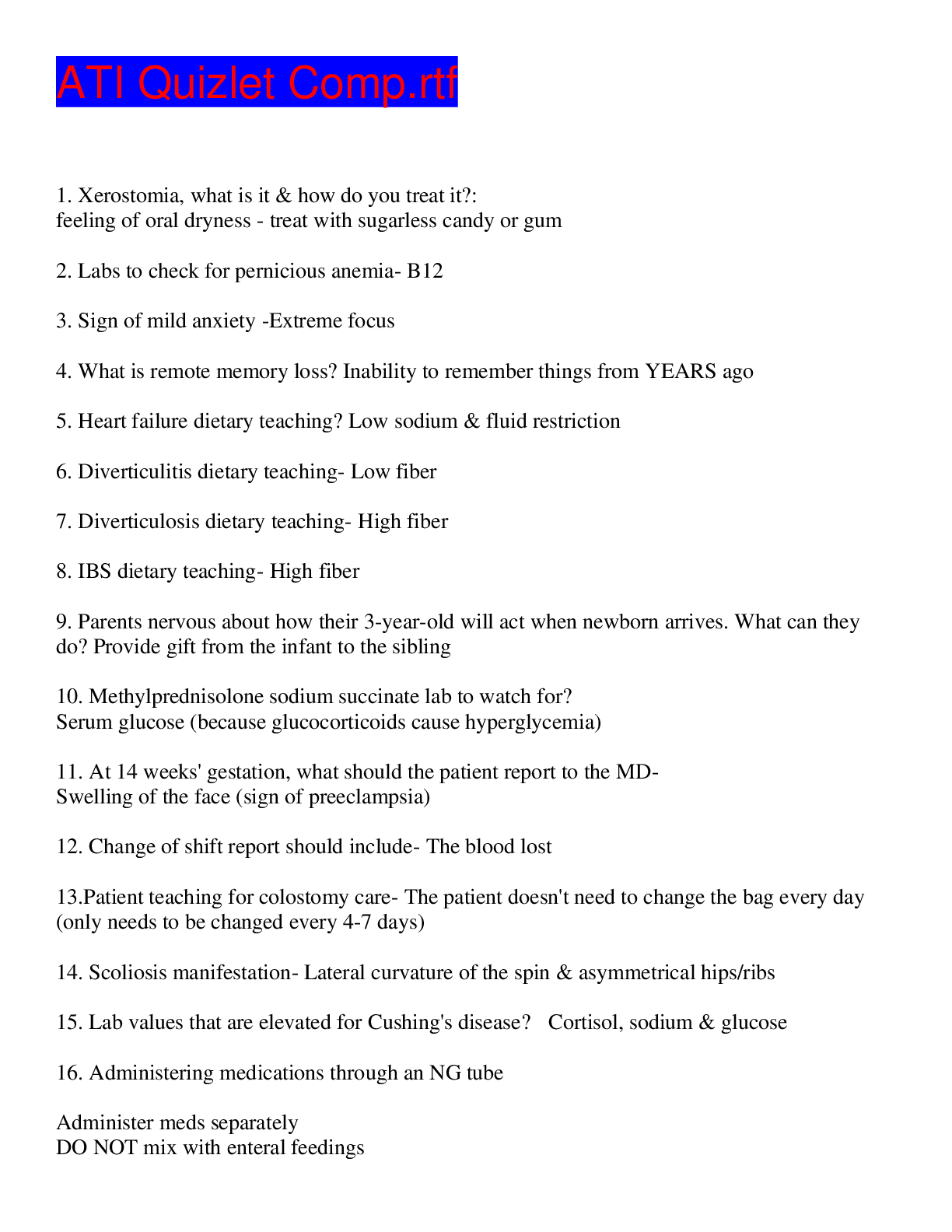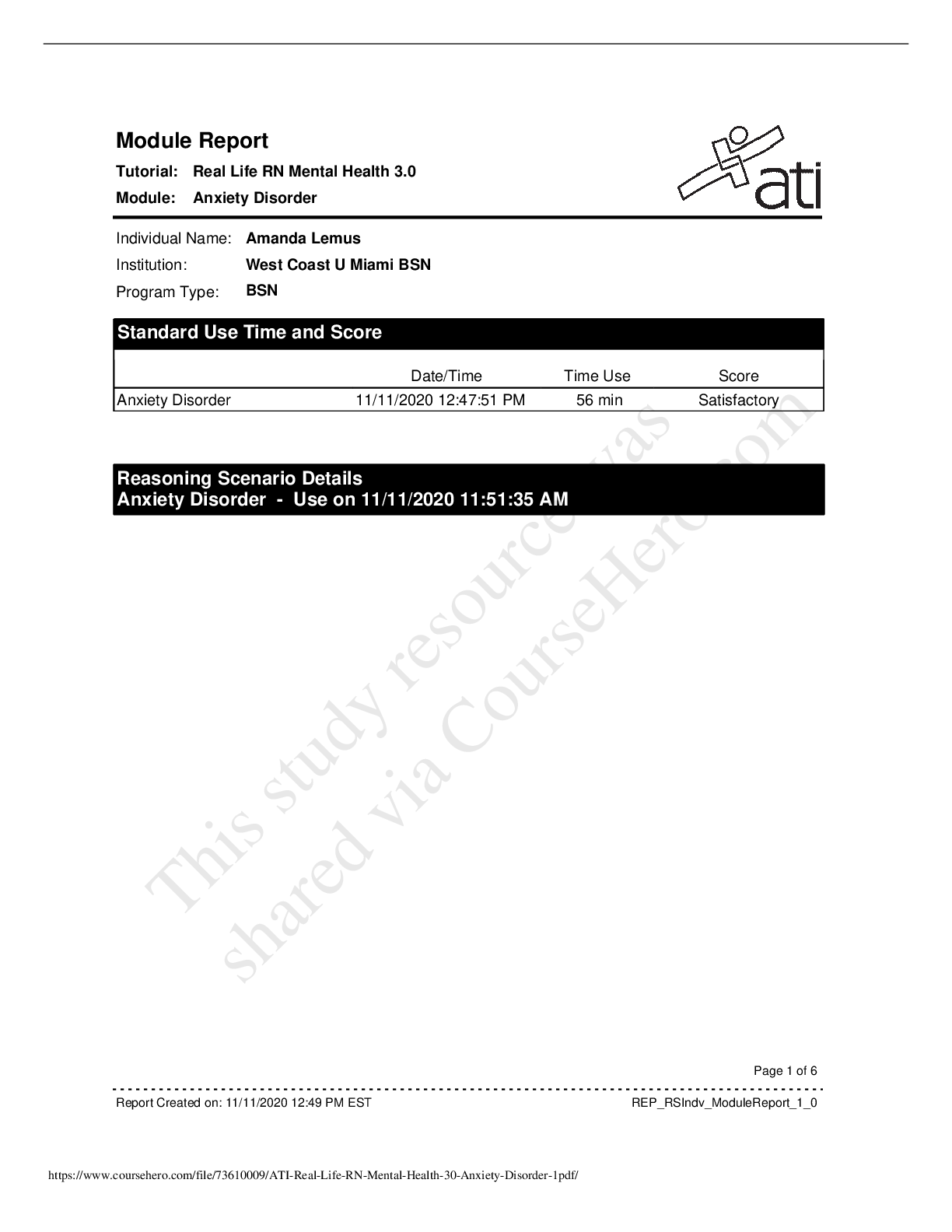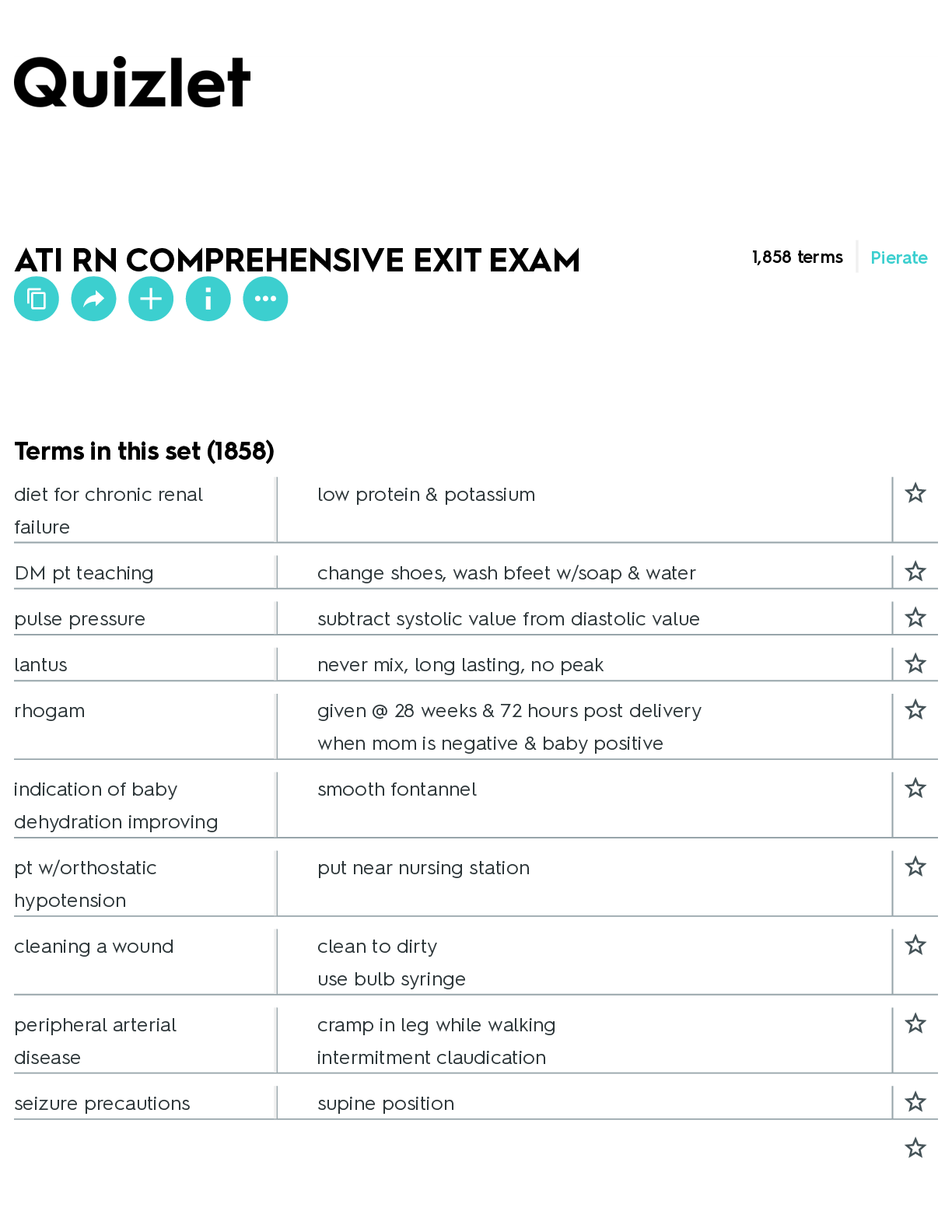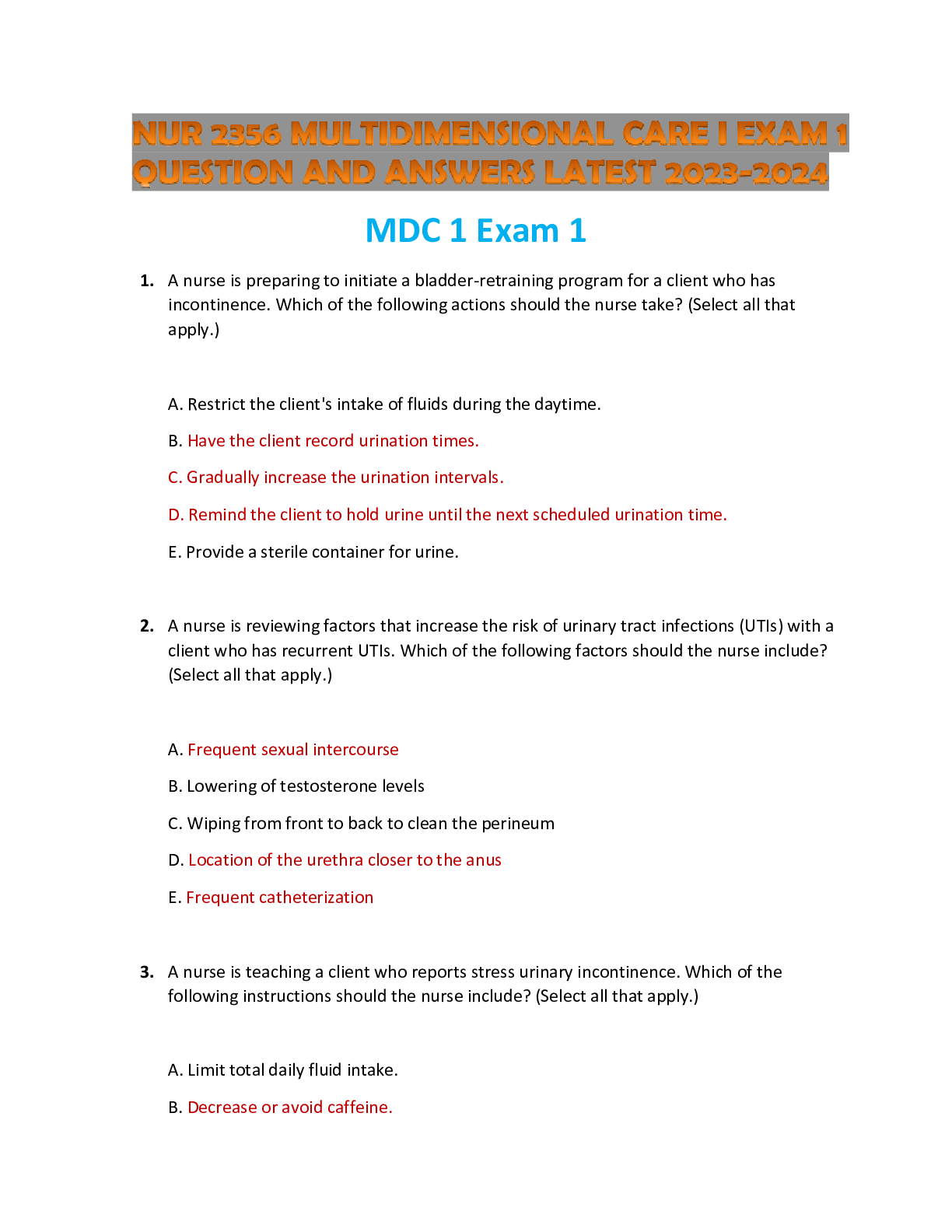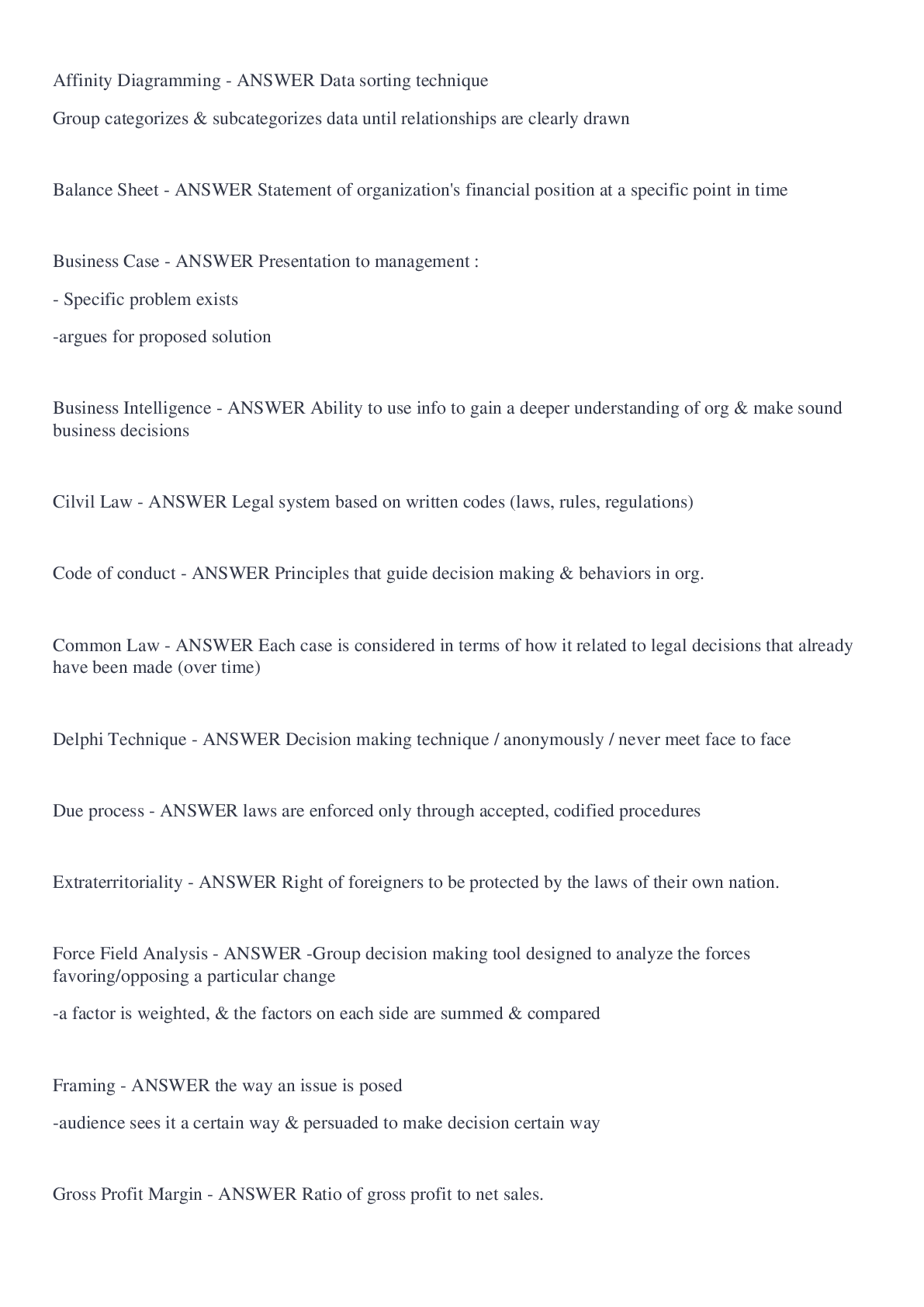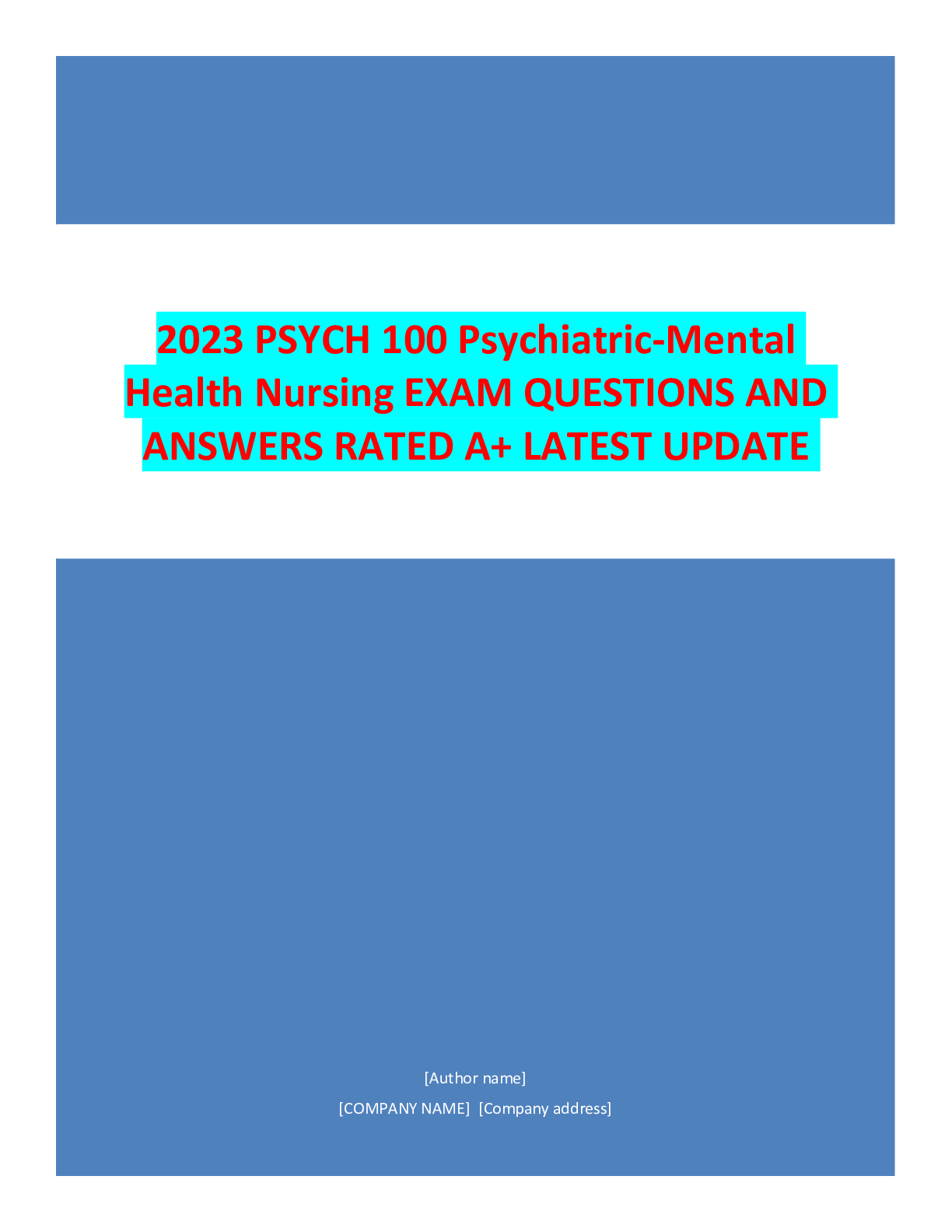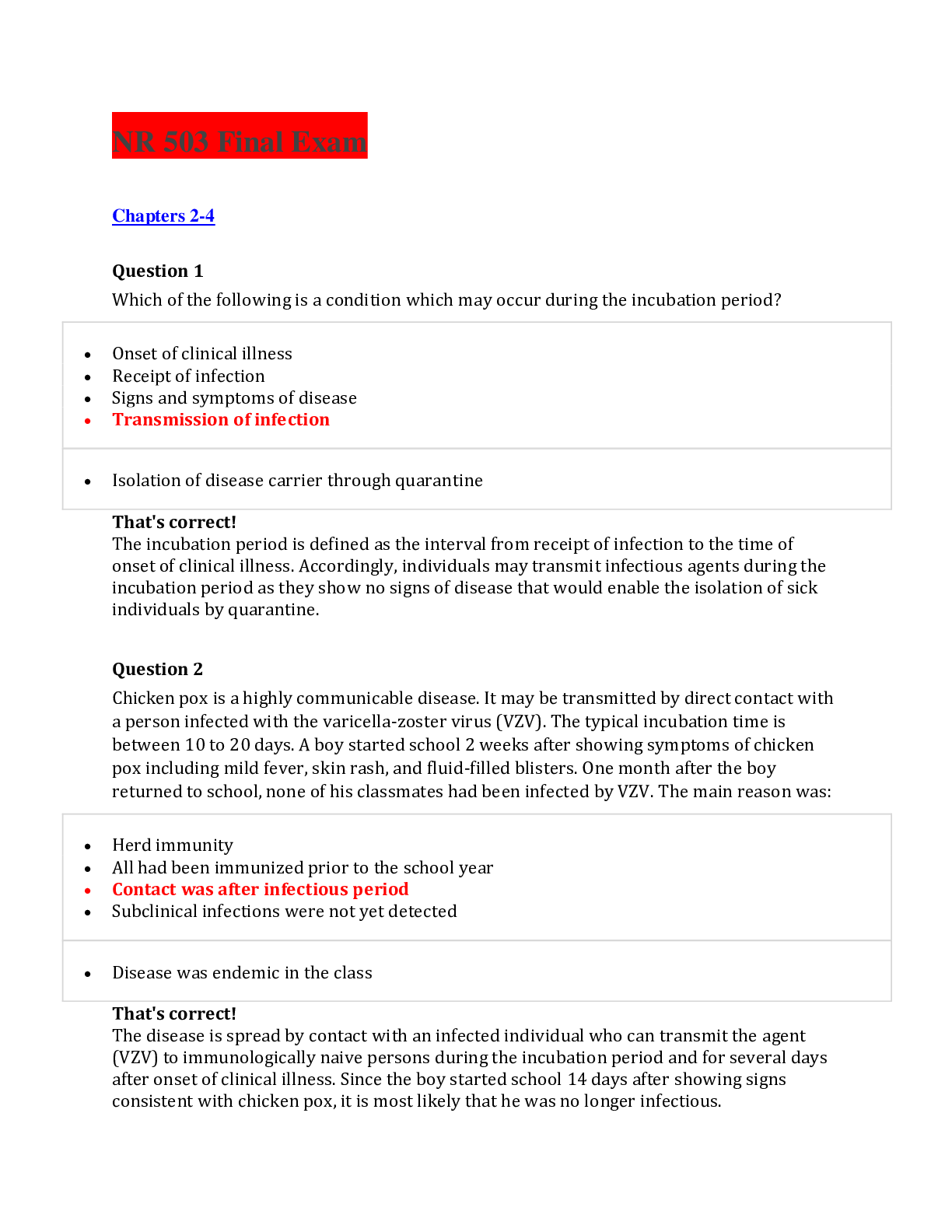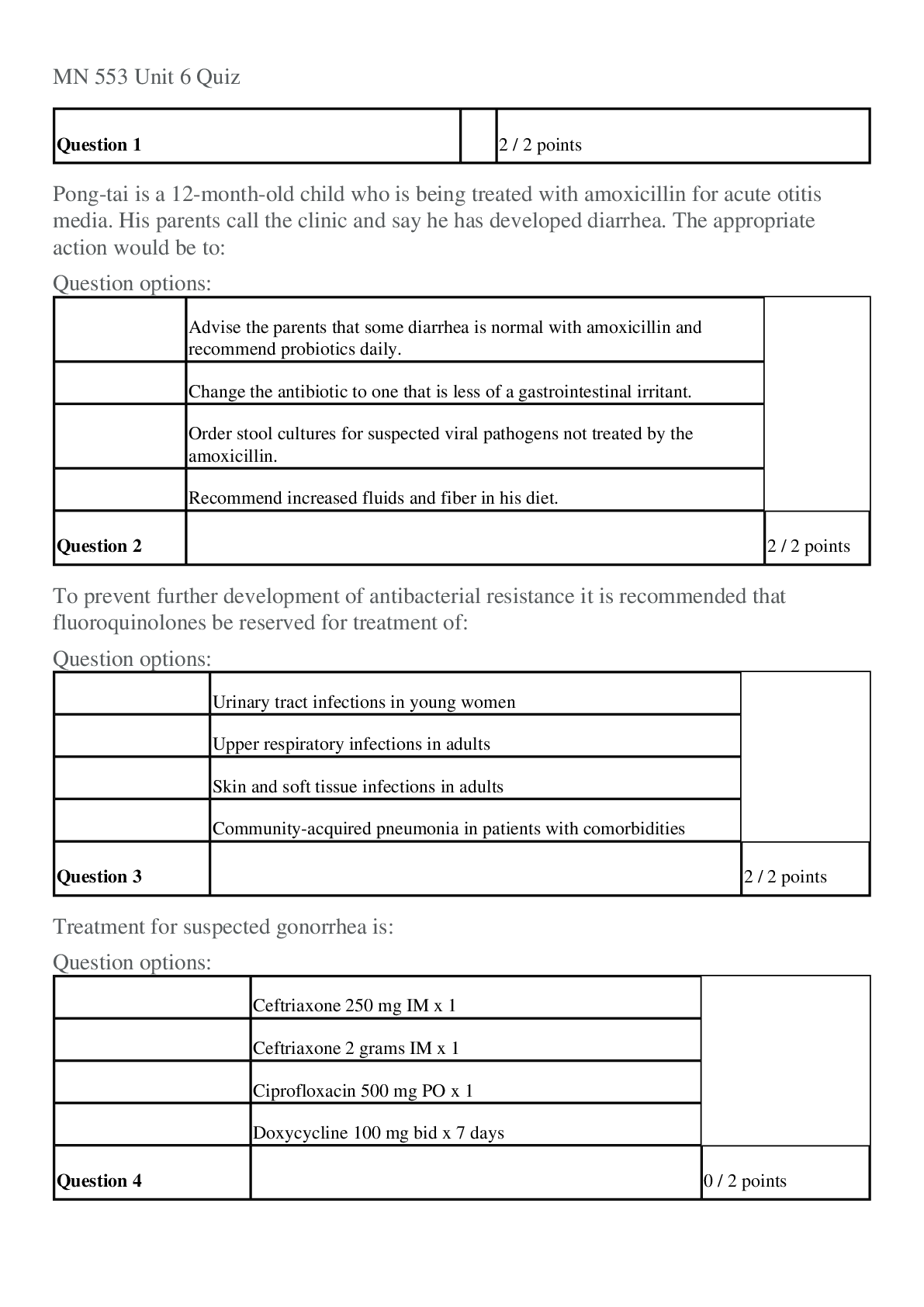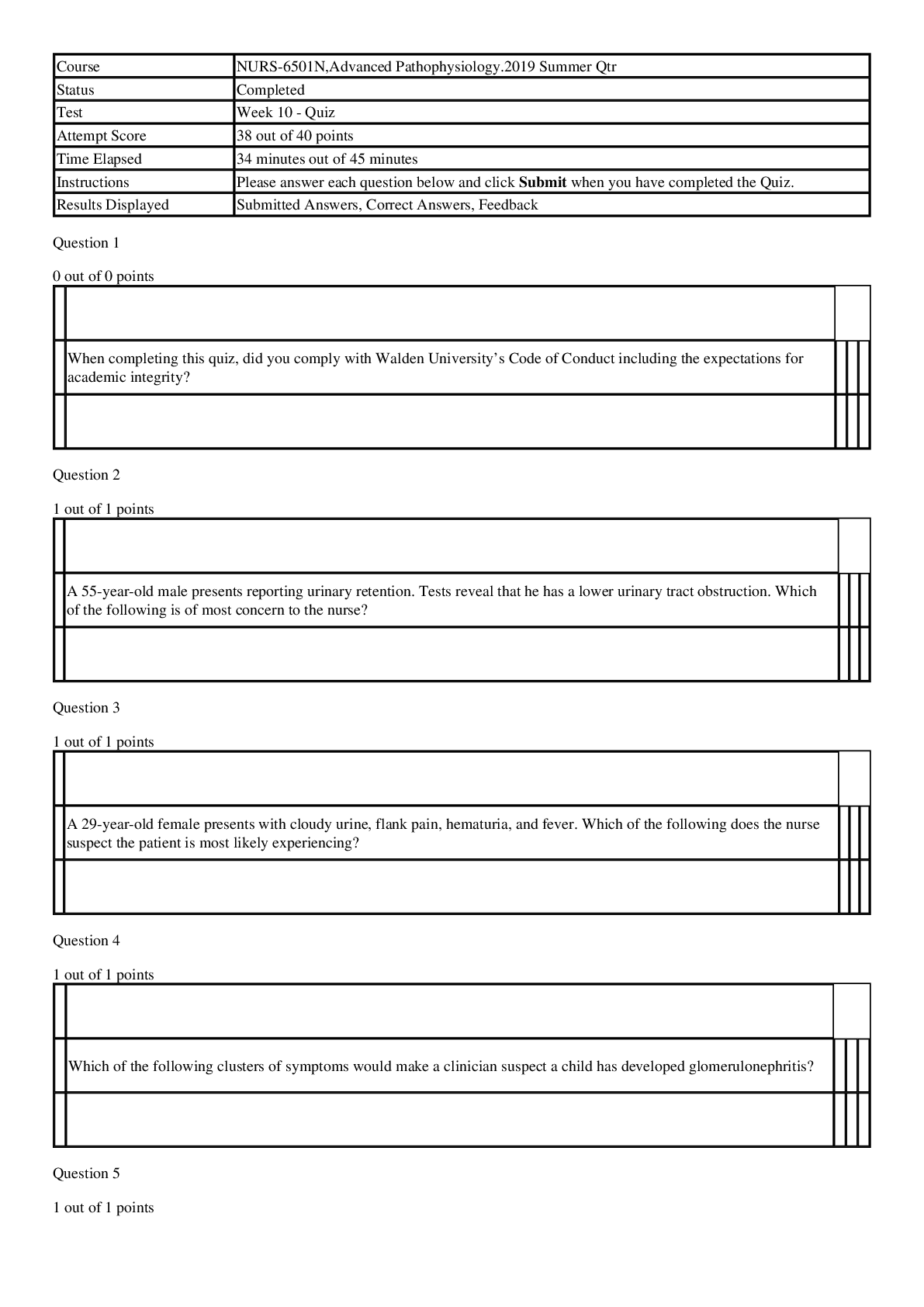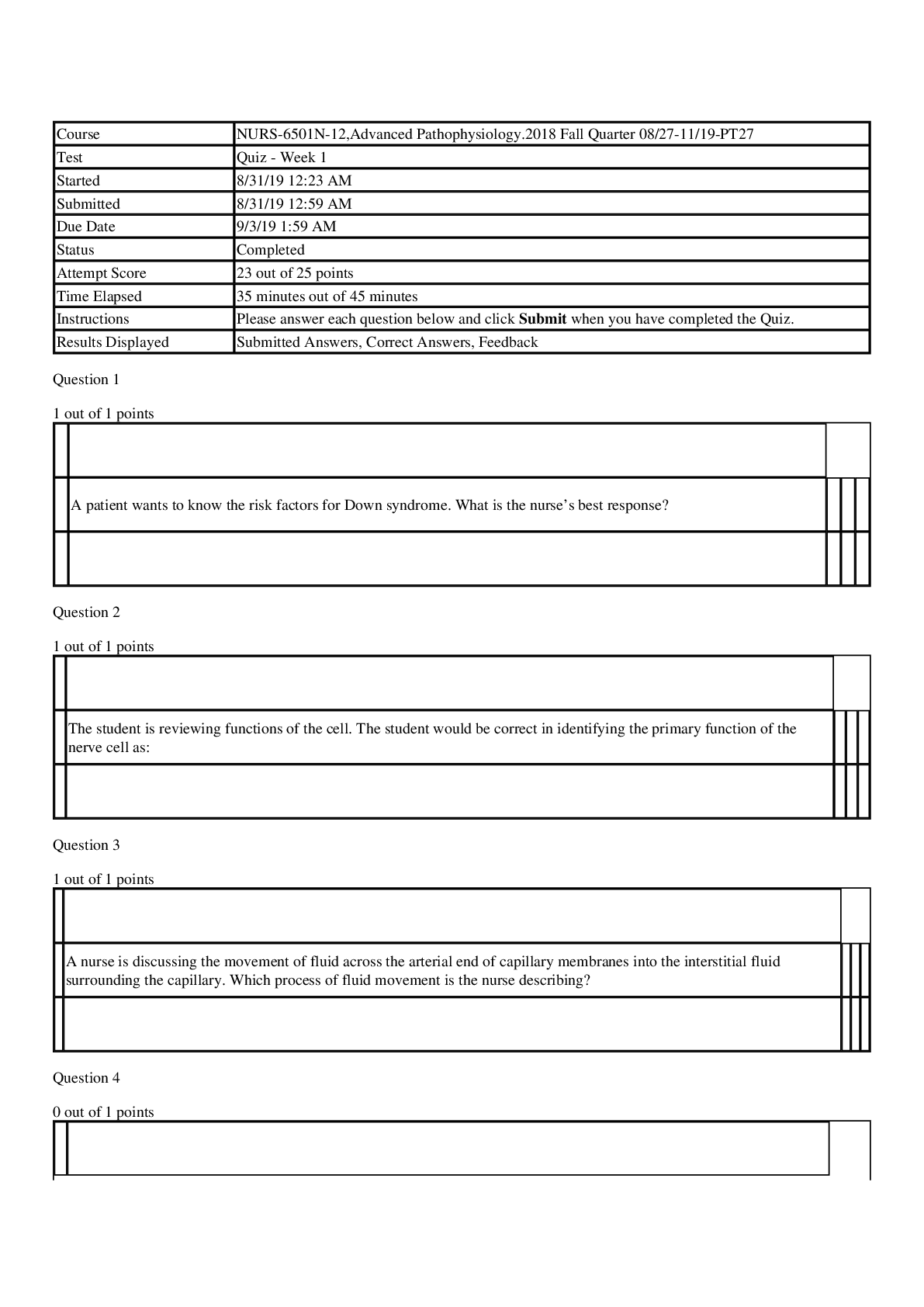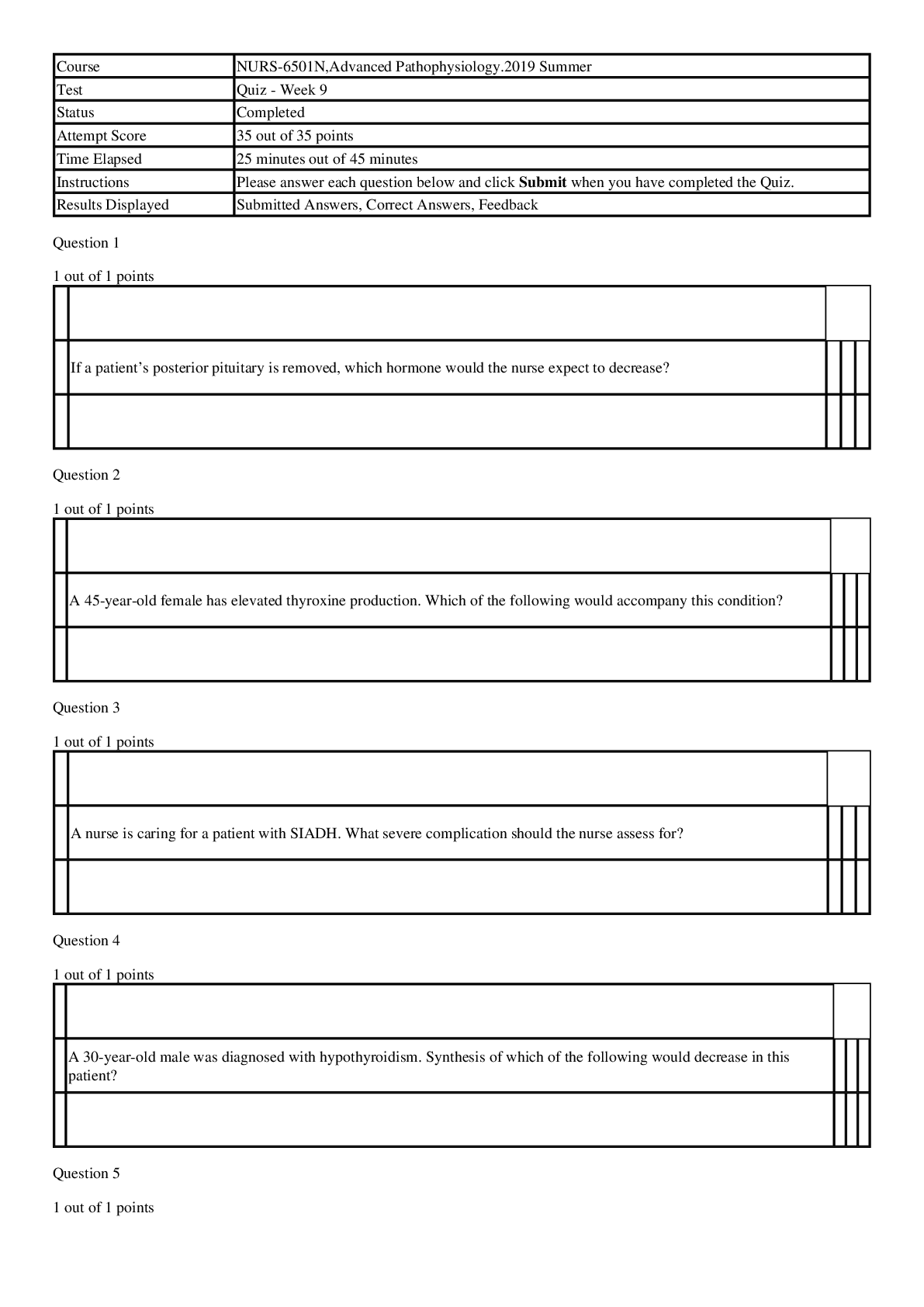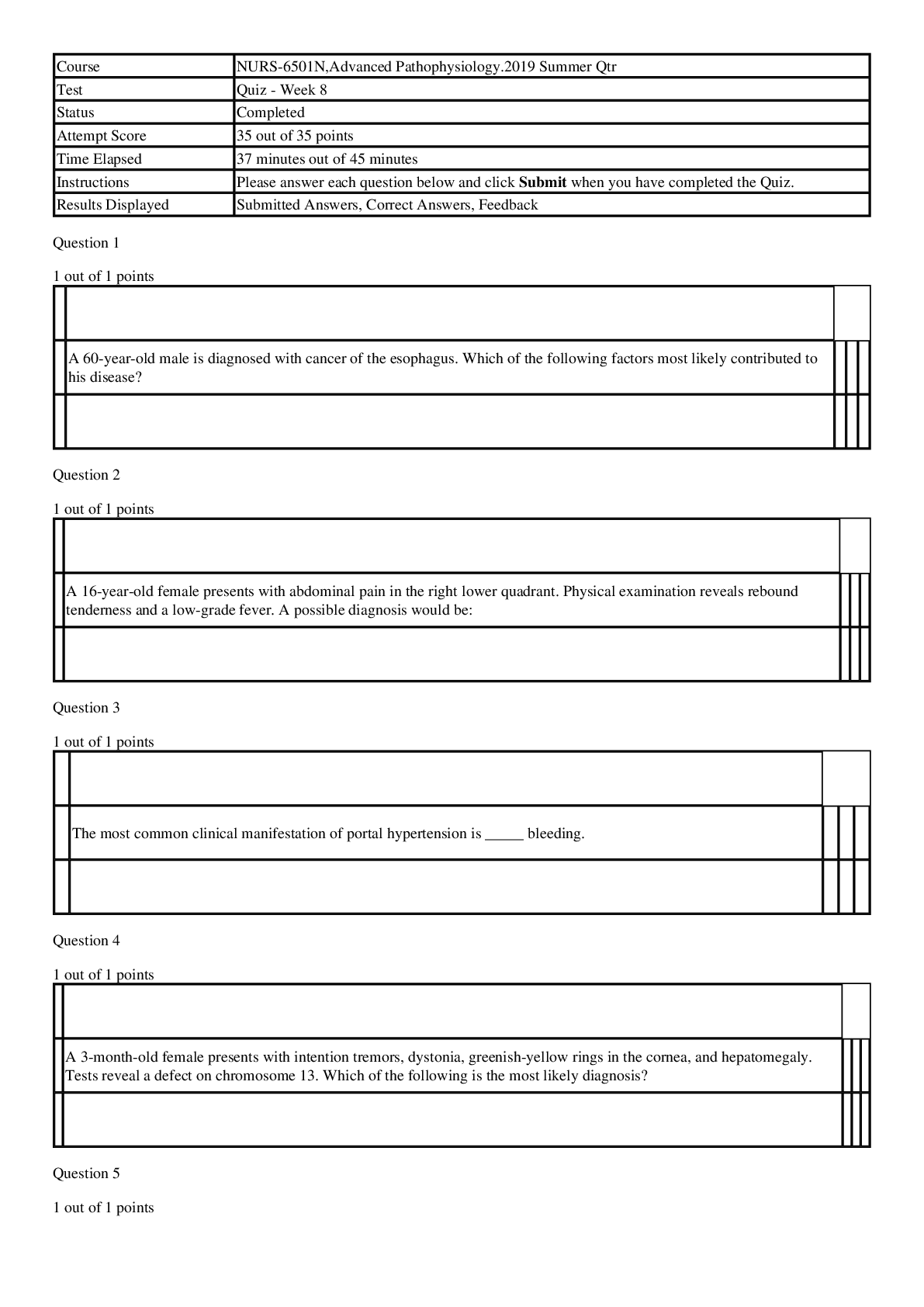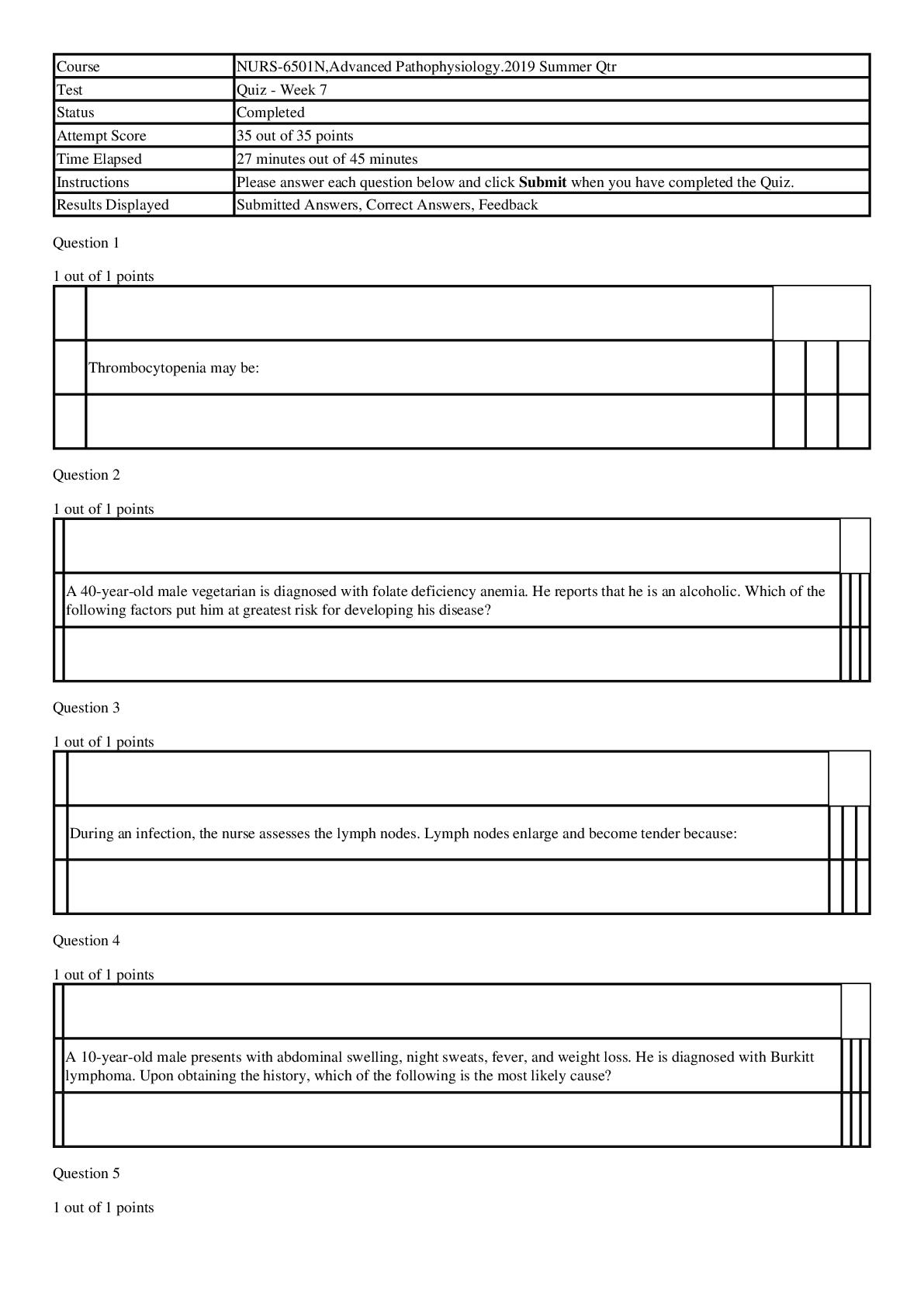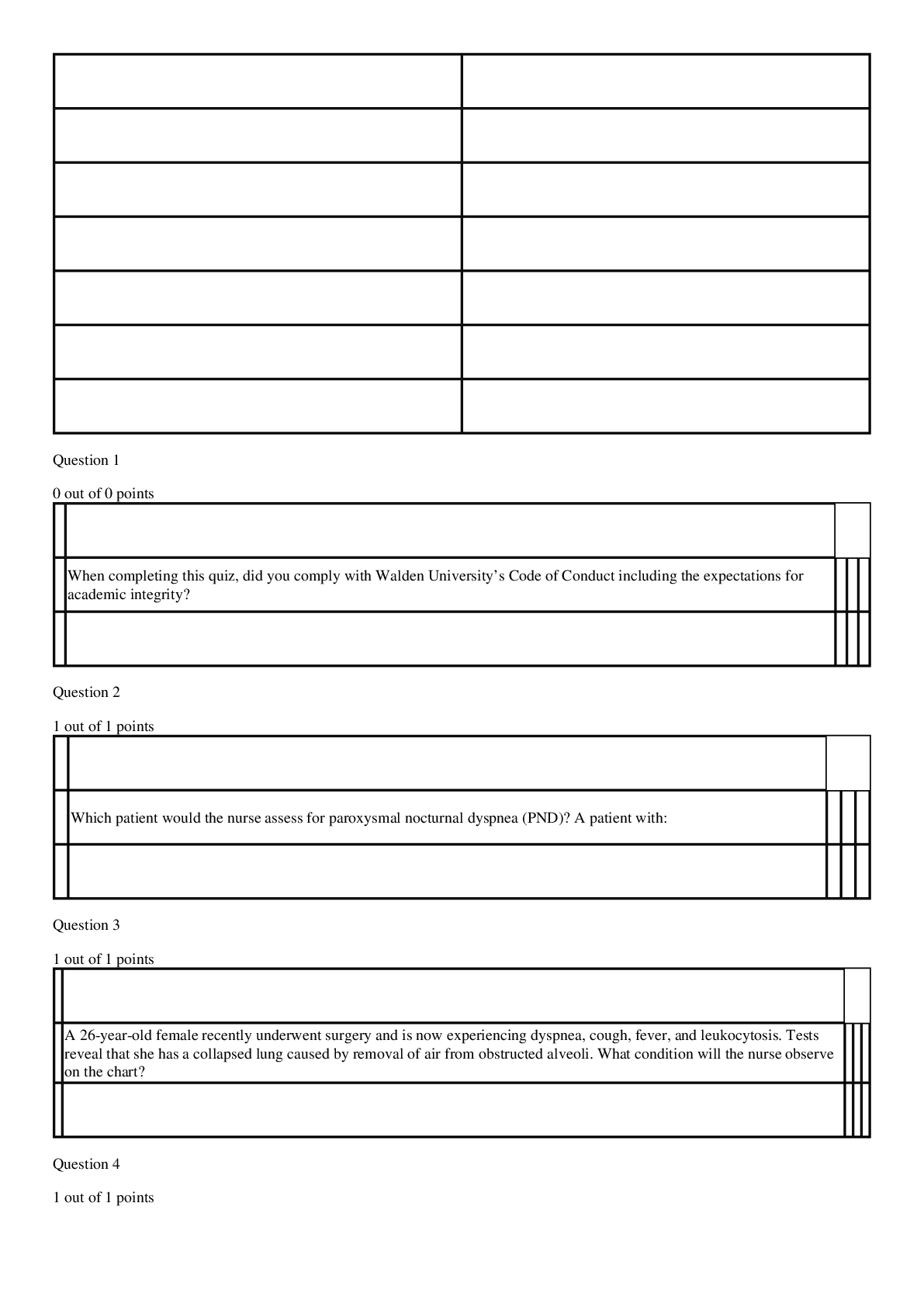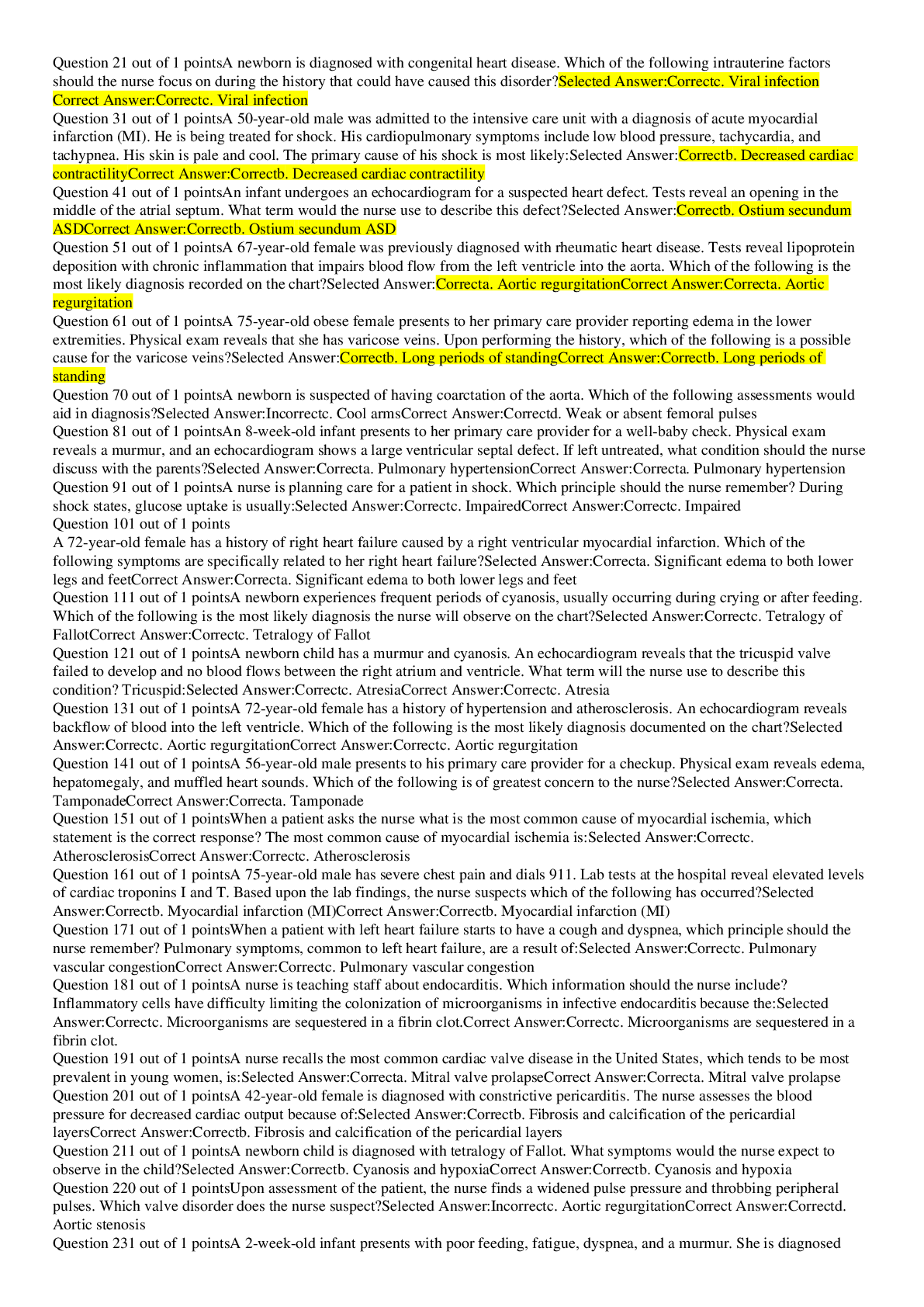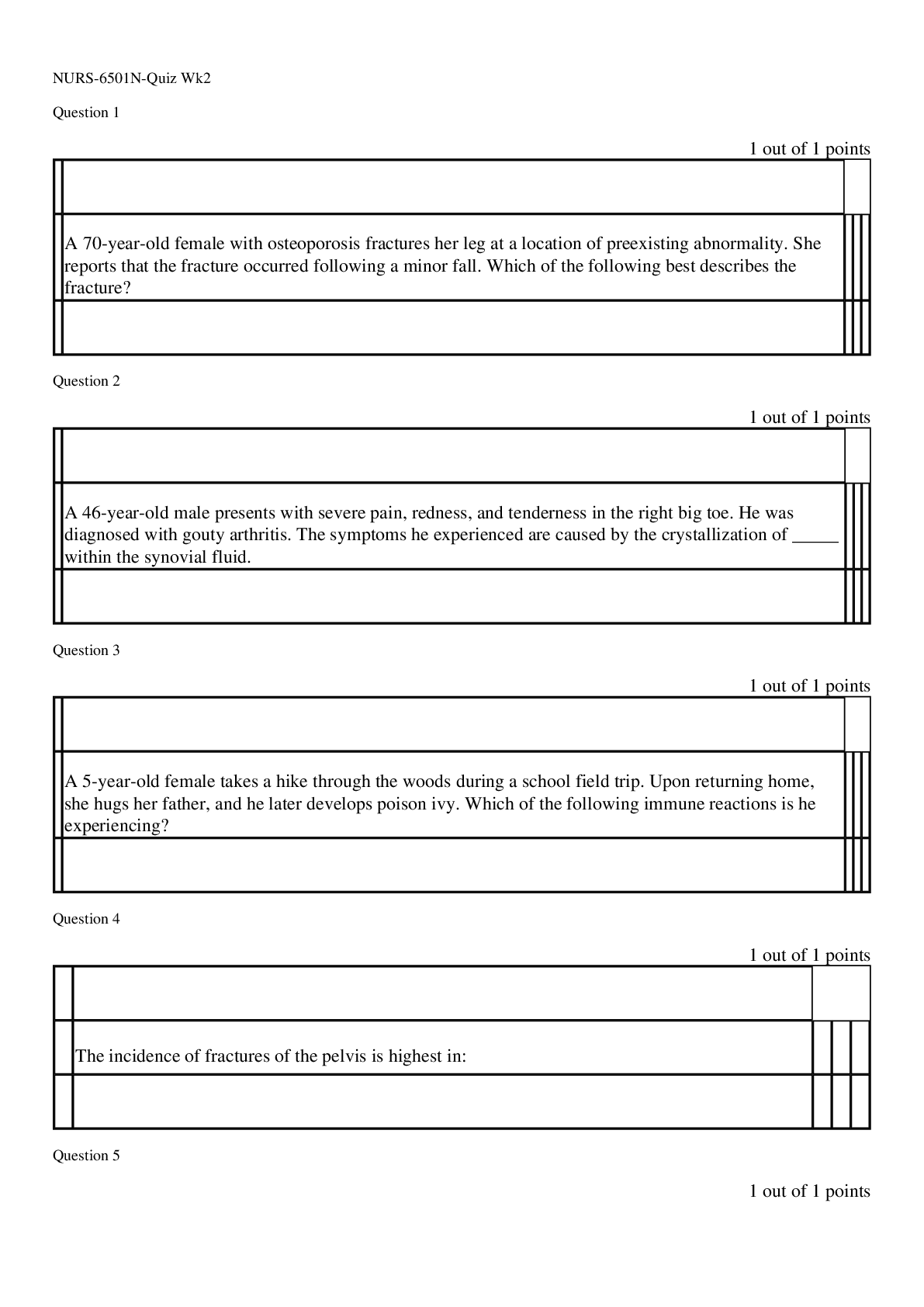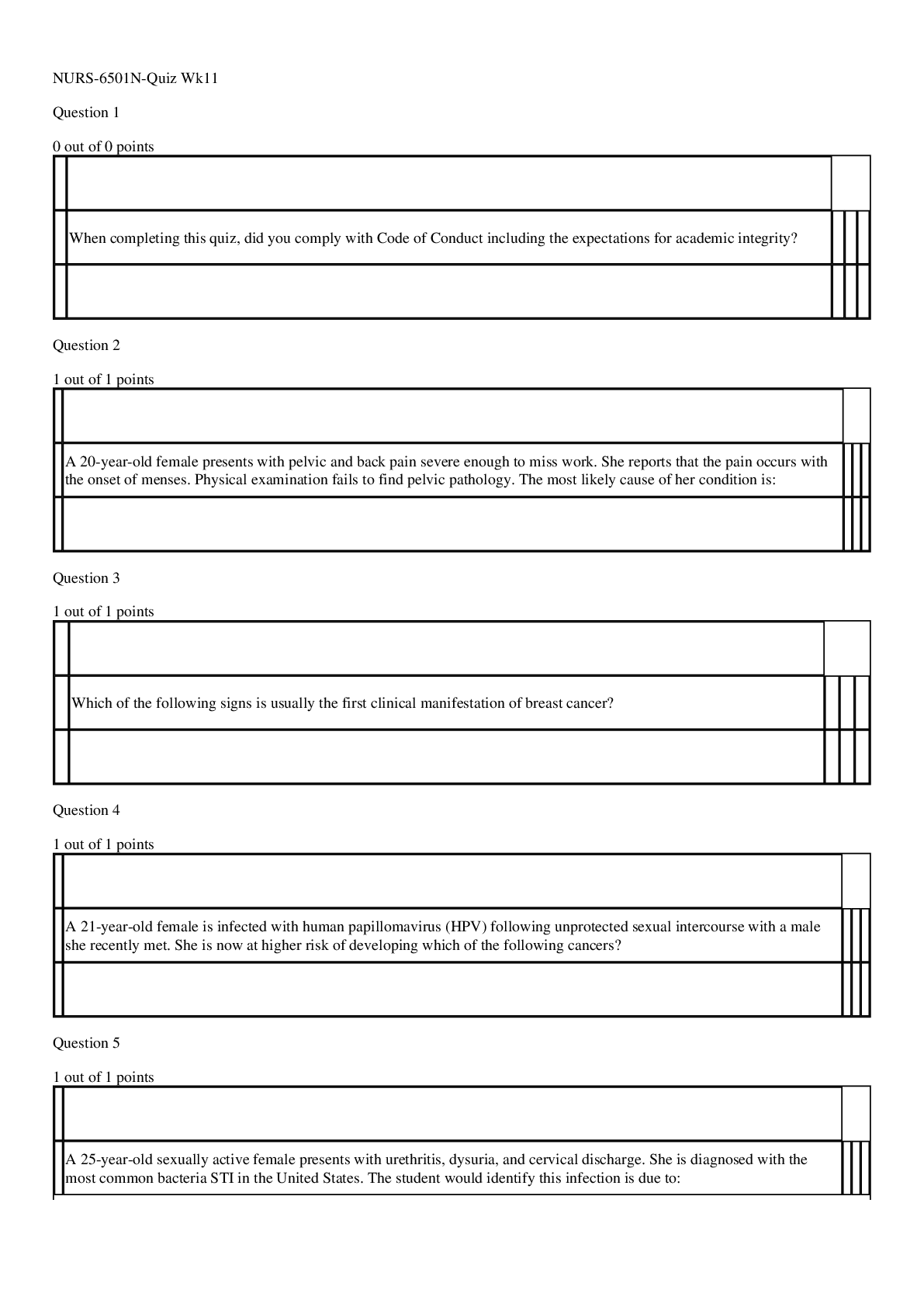ATI fundamental 1 Question And Answers Rated A
Document Content and Description Below
ATI fundamental 1 A nurse is caring for a client who has a terminal illness. The client asks several questions about the nurse's religious beliefs related to death and dying. Which of the following... actions should the nurse take? A) Change the topic because the client is trying to divert attention from the illness to the nurse. B) Encourage the client to express his thoughts about death and dying? C) Tell the client that religious beliefs are a personal matter. D) Offer to contact the client's minister or the facility's chaplain. B A nurse should recognize the client's need to talk about impending death, and encourage the client to discuss his thoughts on the subject. This is therapeutic technique of reflecting. Depending on the situation, the nurse can also share some thoughts on this topic. Self-disclosure is a communication skill that can help open lines of communication when appropriate. If the nurse does not want to share personal beliefs, the communication skills of offering self and listening to the client's thoughts are appropriate. A nurse is preparing to provide tracheostomy care for a client. Which of the following actions should the nurse take first? A) Open all sterile supplies and solutions. B) Stabilize the tracheostomy tube. C) Don sterile gloves. D) Perform hand hygiene. D According to evidence-based practice, the nurse should first perform hand hygiene before touching the client or performing any skills, such as tracheostomy care. This is vital because contamination of the nurse's hands is a primary source of infection. Upgrade to remove ads Only $0.99/month A nurse is measuring vital signs for a client and notices an irregularity in the pulse. Which of the following actions should the nurse take? A) Measure the pulse using a Doppler ultrasound stethoscope. B) Check the client's pedal pulses. C) Count the apical pulse rate for a full minute and describe the rhythm in the chart. D) Take the pulse at each peripheral site and count the rate for 30 seconds. C If the peripheral pulse is irregular, the nurse should auscultate the apical pulse for 1 minute to obtain an accurate rate. The nurse should document irregularity in the client's medical record. A nurse on a med-surg unit is caring for a client. Which of the following actions should the nurse take first when using the nursing process? A) Identify goals for client care. B) Obtain client information C) Document nursing care needs D) Evaluate the effectiveness of care B The nursing process is based on scientific process. The first step in the scientific process is the collection of data. Therefore, the first step is assessing and obtaining information about the client. A nurse is receiving a client from the PACU (post-anesthetic care unit) who is postoperative following abdominal surgery. Which of the following actions should the nurse take to transfer the client from stretcher to the bed? A) Lock the wheels on the bed and stretcher B) Instruct the client to raise his arms above his head C) Elevate the stretch 2.5 cm (1 inch) above the height of the bed D) Log roll the client A Locking the wheels prevents the client from falling to the floor by not allowing the cart of bed to move apart or away from the client. A nurse is admitting a client who has decreased circulation in his left leg. Which of the following actions should the nurse take first? A) Evaluate pedal pulses B) Obtain medical history C) Measure vital signs D) Assess for leg pain A For a client who has decreased circulation in the leg, evaluating pedal pulses is critical in order to determine adequate blood supply to the foot. The nurse should apply the safety and risk reduction priority-setting framework. This framework assigns priority to the factor posing the greatest safety risk to the client. When there are several risks to client safety, the one posing the greatest threat is the highest priority. The nurse should use Maslow's Hierarchy of Needs, the ABC priority-setting framework, or nursing knowledge to identify which risk poses the greatest threat to the client. A nurse is caring for a client who is postoperative and has paralytic ileum. Which of the following abdominal assessments should the nurse expect? A) Frequent bowel sounds with flatus B) Absent bowel sounds with distention C) Hyperactive bowel sounds with diarrhea D) Normal bowel sounds with increased peristalsis B Paralytic ileus is an immobile bowel. With this disorder, bowel sounds are absent and the abdomen is distended A nurse is providing teaching to an older adult client who has constipation. Which of the following statements should the nurse include in the teaching? A) "Drink a minimum of 1,000 ml of fluid daily" B) "Increase your intake of refined-fiber foods" C) "Sit on the toilet 30 mins after eating a meal" D) "Take a laxative everyday to maintain regularity" C Increased peristalsis occurs after food enters the stomach. Sitting on the toilet 30 min after eating a meal, regardless of feeling the urge to defecate, is a recommended method of bowel retraining to treat constipation A nurse is assessing the heart sounds of a client who has developed chest pain that becomes worse with inspiration. the nurse auscultates a high-pitched scratching sound during both systole and diastole with diaphragm of the stethoscope positioned at the left sternal border. Which of the following heart sounds should the nurse document? A) Audible click B) Murmur C) Third heart sound D) Pericardial friction rub D A pericardial friction rub has a high-pitched scratching, grating, or squeaking leathery sound heard best with the diaphragm of the stethoscope at the left sternal border. A pericardial friction rub is a manifestation of pericardial inflammation and can be heard with infective pericarditis with myocardial infarction, following a cardiac surgery or trauma, and with some autoimmune problems, such as rheumatic fever. The client who develops pericarditis typically has chest pain which becomes worse with inspiration or coughing and which may be relieved by sitting up and leaning forward. A nurse is demonstrating postoperative deep breathing and coughing exercises to a client who will have emergency surgery for appendicitis. Which of the following statements indicates a lack of readiness to learn by the client? A) The client asks the nurse to repeat the instructions before attempting the exercises. B) The client reports severe pain C) The client asks the nurse how often deep breathing should be done after surgery. D) The client tells the nurse that this exercise will probably be painful after surgery. B A client who is experiencing severe pain is not able to concentrate and therefore, is not ready to learn a new activity A nurse is teaching a group of older adults about expected changes of aging. Which of the following statements by a group member indicates that the teaching has been effective? A) "I should expect my heart rate to take longer to return to normal after exercise as I get older" B) "Urinary incontinence is something I will have to live with as I grow older" C) "I can expect to have less ear was as I get older" D) "My stomach will empty more quickly after meals as I grow older" A Older adults experience decreased CO, which causes increased pulse rate during exercise. The pulse rate also takes longer to return to normal after exercise. A nurse is caring for a client who has type 1 diabetes mellitus and is resistant to learning self-injection of insulin. Which of the following statements should the nurse make? A) "Tell me what I can do to help you overcome your fear of giving yourself injections" b) "I am sure your provider will not be pleased that you refuse to give yourself insulin injections" C) "It's okay. I'm sure your partner will be able to learn how to give you the insulin injections" D) "You won't be able to go home unless you learn to give yourself insulin injections" A The response illustrates the therapeutic communication technique of clarifying and offering of self. It is important for the nurse to allow the client to express feelings and fears and to support the client in learning how to give the injections. Upgrade to remove ads Only $0.99/month A nurse is providing preoperative teaching to a client who is scheduled for arthroplasty in the next month that might require a blood transfusion. The client expresses concern about the risk of acquiring an infection from the blood transfusion. Which of the following statements should the nurse make to the client? A) "Ask your provider to prescribe epoetin before the surgery" B) "You should ask your provider about taking iron supplements prior to the surgery" C) "Request a family member to donate blood for you" D) "Donate autologous blood before the surgery" D Autologous blood transfusion is the collection and reinfusion of the client's blood. With preoperative autologous blood donation, the blood is drawn from the client 3-5 week before an elective surgical procedure and stored for transfusion at the time of the surgery. Autologous blood is the safest form of blood transfusion because exclusive use of a client's own blood eliminates exposure to transfusion-transmitted infection. A charge nurse is observing a newly licensed nurse perform tracheostomy care for a client. Which of the following actions by the newly licensed nurse requires intervention? A) Obtaining hydrogen peroxide for the tracheostomy care b) Obtaining cotton balls for the tracheostomy care c) Obtaining sterile gloves for the tracheostomy care d) Obtaining a sterile brush for the tracheostomy care B Cotton ball particles can be aspirated into the tracheostomy opening, possibly causing a tracheal abscess. The charge nurse should intervene for this action A nurse observes an assistive personnel (AP) preparing to obtain blood pressure with a regular size cuff for a client who is obese. Which of the following explanations should the nurse give the AP? A) "The reading will be inaudible if the cuff is too small for the client" B) "The width of the cuff bladder should be 75% of the circumference of the client's arm" C) "As long as the cuff will circle the arm the reading will be accurate" D) "Using a cuff that is too small will result in an inaccurately high reading" D Blood pressure cuffs come in various sizes, and the correct size cuff is necessary to obtain a reliable measurement. Blood pressure readings can be falsely high if the cuff is too small for the client. A nurse is caring for a client who requires a chest x-ray. Prior to the client being transported for the procedure, which of the following actions should the nurse take first? A) Explain the x-ray procedure to the client B) Help the client into a wheelchair before the transporter arrives C) Ask if the client has any questions D) Identify the client using two identifiers D The nurse should apply the safety and risk reduction priority-setting framework. This framework assigns priority to the factor or situation posing the greatest safety risk to the client. When there are several risks to client safety, the one posing the greatest threat is the highest priority. The nurse should use Maslow's Hierarchy of Needs, the ABC priority-setting framework, or nursing knowledge to identify which risk poses the greatest threat to the client. Once the client's identity is determined, the nurse can then proceed with the other options. This action is the priority action because it provides for the safety of the client. It is a nursing responsibility to be certain that each client receives only what has been prescribed. The nurse must assure that the correct client is being transported for the chest x-ray. A nurse is obtaining the blood pressure in a client's lower extremity. Which of the following actions should the nurse take? A) Auscultate for the BP at the dorsalis pedis artery B) Measure the BP with the client sitting on the side of the bed C) Place the cuff 7.6 cm (3 inches) above the popliteal artery D) Place the bladder of the cuff over the posterior aspect of the thigh D This is the correct position for the nurse to place the bladder of the cuff when measuring a lower extremity BP A nurse is caring for a child who is postoperative following a tonsillectomy. Which of the following actions should the nurse take? A) Encourage the child to cough frequently to clear congestion from anesthesia B) Place a heating pad at the child's neck for comfort C) Administer analgesics to the child on a routine schedule throughout the day and night D) Provide the child with icecream when oral intake is initiated C To sooth the client's throat following a tonsillectiomy, the nurse should administer pain medication routinely around the clock. The nurse can provide the medication rectally or intravenously to avoid the oral route. A nurse is caring for an older adult client who is violent and attempting to disconnect her IV lines. The provider prescribes soft wrist restraints. Which of the following actions should the nurse take while the client is in restraints? A) Tie restraints to the side rails B) Perform ROM exercises to the wrists every 3hr C) Remove restraints one at a time D) Obtain a PRN prescription for the restraints C The nurse should remove one restraint at a time for a client who is violent or noncompliant A charge nurse is teaching adult cardiopulmonary resuscitation (CPR) to a group of newly licensed nurses. Which of the following actions should the charge nurse teach as the first response in CPR? A) Call for assistance B) Begin chest compressions C) Confirm unresponsiveness D) Give rescue breaths C The nurse should apply the nursing process priority-setting framework. The nurse can use the nursing process to plan client care and prioritize nursing actions. Each step of the nursing process builds on the previous step, beginning with the assessment or data collection. Before the nurse can formulate a plan of action, implement a nursing intervention or notify a provider of a change in the client's status, she must first collect adequate data from the client. Assessing or collecting additional data will provide the nurse with knowledge to make an appropriate decision. Establishing unresponsiveness is required before beginning CPR. If a client is unresponsive, the nurse should activate the emergency response team. A nurse is planning to obtain the vital signs of a 2-year-old child who is experiencing diarrhea and who might have a right ear infection. Which of the following routes should the nurse use to obtain the temperature? A) Rectal B) Tympanic C) Oral D) Temporal D The temporal artery route, while not as accurate as the rectal route for obtaining a precise body temperature, is noninvasive and can be used to obtain a temperature in a toddler who might have an ear infection and who is having diarrhea. The nurse should place the probe behind the ear if the client is diaphoretic, but should avoid placing it over an area covered with hair. A nurse at a screening clinic is assessing a client who reports a history of a heart murmur related to aortic valve stenosis. At which of the following anatomical areas should the nurse place the stethoscope to auscultate the aortic valve? A) 5th intercostal space just medial to the midclavicular line B) 2nd intercostal space to the left of the sternum C) 5th intercostal space to the left of the sternum D) 2nd intercostal space to the right of the sternum D The aortic valve is located at the second intercostal space to the right of the sternum. Aortic stenosis produces a midsystolic ejection murmur that can be heard clearly at the aortic area with the client leaning forward. [Show More]
Last updated: 1 year ago
Preview 1 out of 9 pages
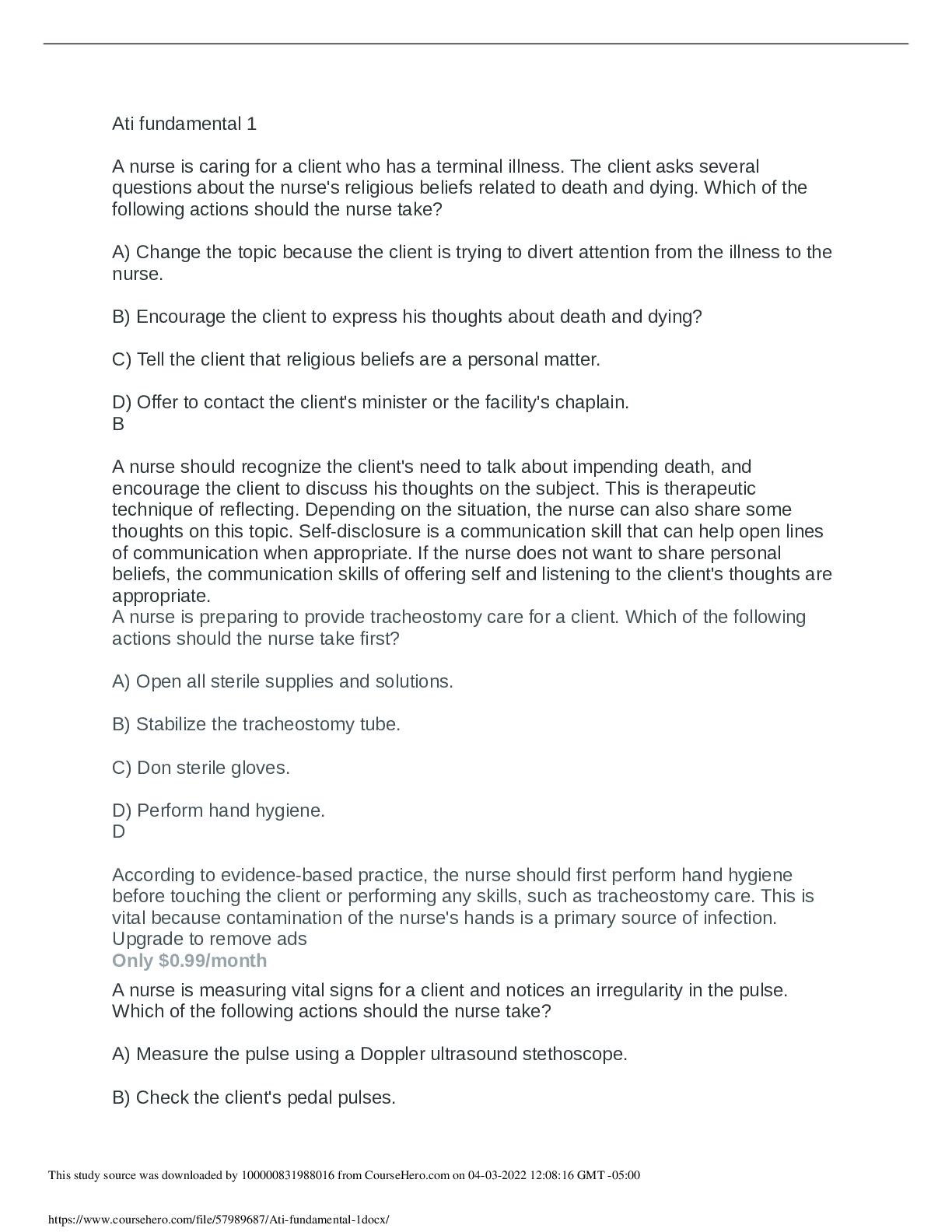
Reviews( 0 )
Document information
Connected school, study & course
About the document
Uploaded On
Mar 18, 2021
Number of pages
9
Written in
Additional information
This document has been written for:
Uploaded
Mar 18, 2021
Downloads
0
Views
58

.png)
.png)
.png)
.png)
.png)
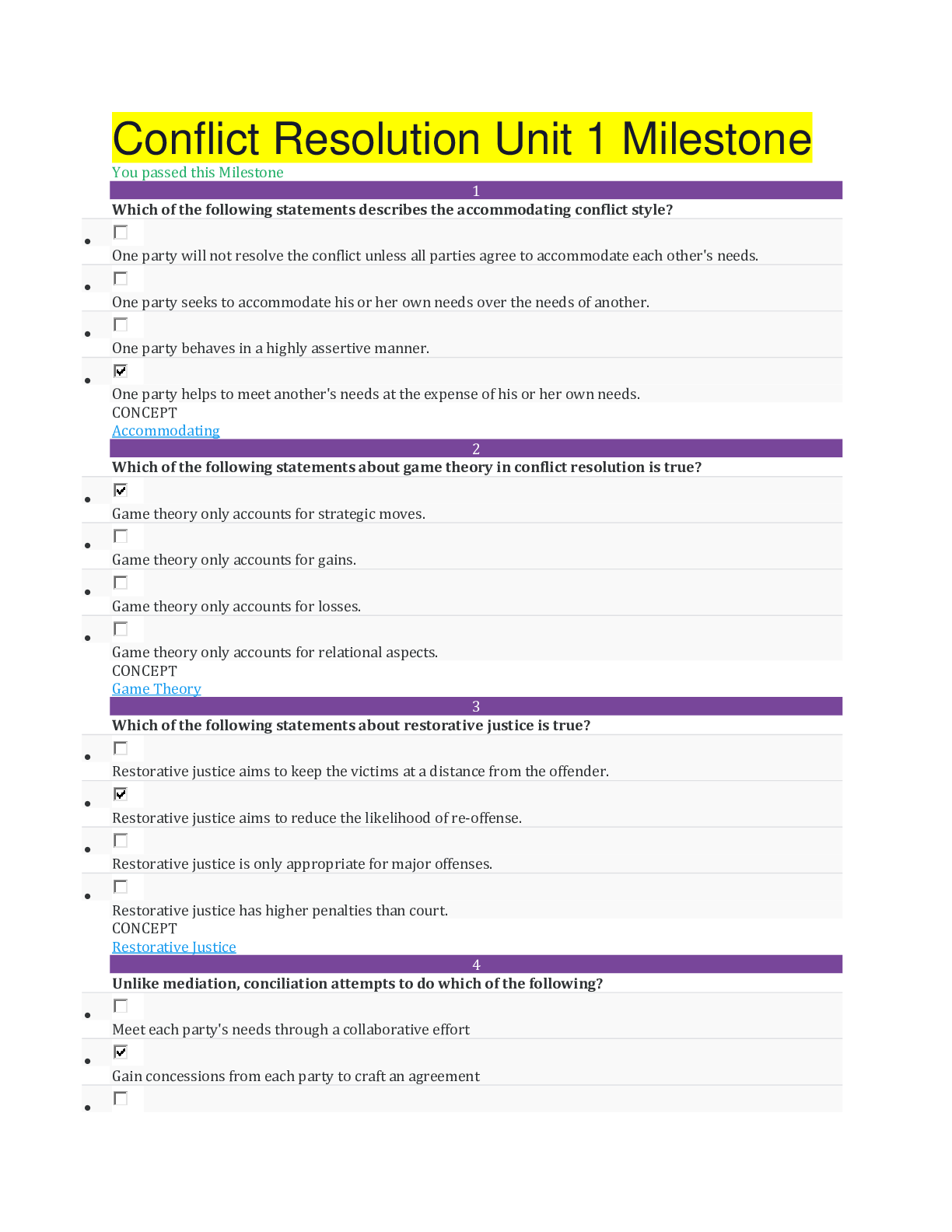
.png)

